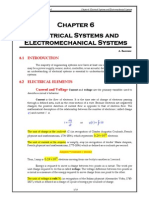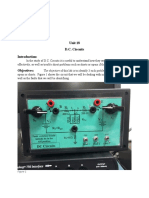Lec 4 BE
Lec 4 BE
Uploaded by
alaaelk943Copyright:
Available Formats
Lec 4 BE
Lec 4 BE
Uploaded by
alaaelk943Copyright
Available Formats
Share this document
Did you find this document useful?
Is this content inappropriate?
Copyright:
Available Formats
Lec 4 BE
Lec 4 BE
Uploaded by
alaaelk943Copyright:
Available Formats
Introduction To Electronics
Lec 4
Dr. M. Hebaishy
Digital Logic Design Ch1-1
KIRCHHOFF’S CURRENT LAW
In 1847 Kirchhoff extended Ohm’s law with two important Kirchhoff’s laws. The
Kirchhoff’s current law and Kirchhoff’s Voltage law
Kirchhoff’s current law is:
• The total current flowing into a junction is equal to the sum of the current
flowing out of that junction.
In Figure, point A is one junction and point B is the second junction.
The current in the circuit, IT flows from the voltage source into the junction at point A
There the current splits among the three branches as shown. Each of the three branch
currents (I1, I2, and I3) flows out of junction A.
According to Kirchhoff’s current law: IT = I 1 + I 2 + I 3
Following the current through each of the three branches finds them coming back together
at point B. Currents I1, I2, and I3 flow into junction B, and IT flows out.
I1 + I2 + I 3 = IT Digital Logic Design Ch1-2
Quiz
In a parallel circuit with two branches, one branch has 2 mA of
current flowing through it. The total current is 5 mA. What is the
current through the other branch?
In Fig.
What are the values of I2 and I3?
Digital Logic Design Ch1-3
KIRCHHOFF’S VOLTAGE LAW
Kirchhoff’s second law is Kirchhoff’s voltage law, it states:
The algebraic sum of all the voltages around a closed circuit equals zero.
OR , The sum of all the voltage drops in a closed circuit will equal the voltage
source.
In the circuit. If the voltages are summed around the circuit as shown, they equal
zero.
ET - E1 - E2 - E3 = 0
Notice that the voltage source (ET) has a sign opposite that of the voltage drops.
Therefore the algebraic sum equals zero.
The sum of all the voltage drops will equal the voltage source.
ET = E1 + E2 + E3
Digital Logic Design Ch1-4
Quiz
A series circuit has two identical resistors connected in series with a 9-volt
battery. What is the voltage drop across each resistor?
A series circuit is connected to a 12-volt voltage source with three resistors. One
resistor drops 3 V and another resistor drops 5 V. What is the voltage drop across
the third resistor?
Refer to Figure What is the total voltage applied to the circuit?
Digital Logic Design Ch1-5
SELF-TEST
Using Ohm’s law, find the unknown value for the following:
1. I= ? , E= 9 V, R = 4500 ohms
2. I = 250 mA, E= ? , R = 470 ohms
3. I = 10 A , E = 240 V, R= ?
Find the current and voltage drop through each component for the circuits shown
below.
Use Kirchhoff’s laws to verify answers for the circuits shown below.
Digital Logic Design Ch1-6
POWER
Power can be defined at the rate which energy is dissipated in a circuit.
As mentioned, the basic unit of power is the watt.
A watt is equal to the voltage across a circuit multiplied by the current through
the circuit.
The symbol P represents electrical power.
The relationship of power, current, and voltage may be expressed as follows:
P= I X E
Example: What voltage is required to deliver 2 amperes of current at 200 watts?
How much current does a 100-watt, 120-volt light bulb use?
Digital Logic Design Ch1-7
POWER APPLICATION (CIRCUIT ANALYSIS)
Resistive components in a circuit consume power. To determine the power
dissipated by a component, multiply the voltage drop across the component by the
current flowing through the component.
P = IE
The total power dissipated in a series or parallel circuit is equal to the sum of the
power dissipated by the individual components. This can be expressed as:
PT = PR1 + PR2 + PR3 . . . +PRn
The power dissipated in a circuit is often less than 1 watt.
Digital Logic Design Ch1-8
Example
How much power is consumed in the circuit ?
- First determine the total resistance
for the circuit.
Now determine the total current flowing in the circuit, using Ohm’s law.
Digital Logic Design Ch1-9
The total power consumption can now be determined using the power formula.
Digital Logic Design Ch1-10
Example 2
What is the value of resistor R2 in the circuit ?
First determine the voltage drop across resistor R1.
In a parallel circuit the voltage is the same in all branches.
Now the current through resistor R2 can be determined.
Digital Logic Design Ch1-11
The resistance value of R2 can now be determined using Ohm’s law.
Digital Logic Design Ch1-12
Example 3
If a current of 0.05 ampere flows through a 22-ohm resistor, how much power is
dissipated by the resistor?
The voltage drop across the resistor must first be determined using Ohm’s
law.
The power consumed by the resistor can now be determined using the power
formula.
Digital Logic Design Ch1-13
Quiz
What is the power consumed
by each resistor in the circuit .
What is the power consumed by
each resistor in the circuit.
What is the power consumed
by each resistor in the circuit.
Digital Logic Design Ch1-14
The source voltage is divided on 5 lamps by eqaul.
Elamp=220/5=44 v (each lamp consume 44 v compared Max
v =220 v ) the result is light strength is low.
Digital Logic Design Ch1-15
Electrical Energy
E = P(kw) x Time (hour)= kwh
Digital Logic Design Ch1-16
Example
The heater power is 2 kw works 8 hours calculate the total energy
consumption , calculate the total cost if kwh=0.3 Pounds
E=P x T =2 * 8 = 16 kwh
Total cost = Total power x price(kwh)=16 x 0.3 = 4.8 pounds
Digital Logic Design Ch1-17
KVL Example
Calculate the Current at each
resistance
Apply KCL at point A
Apply KVL left and whole loop:
Digital Logic Design Ch1-18
SELF-TEST
Digital Logic Design Ch1-19
END
Digital Logic Design Ch1-20
You might also like
- Ultracision Harmonic Scalpel Generator 300Document34 pagesUltracision Harmonic Scalpel Generator 300nenecioNo ratings yet
- A. Basic ConceptsDocument40 pagesA. Basic ConceptsBarkley VelezNo ratings yet
- Chapter1 DC SystemDocument36 pagesChapter1 DC SystemBrian LiNo ratings yet
- Unit IDocument50 pagesUnit IThiaga RajanNo ratings yet
- Files 2-Chapters Chapter 6 Electrical and Electromechanical Systems 2Document19 pagesFiles 2-Chapters Chapter 6 Electrical and Electromechanical Systems 2Naveen KrishnaNo ratings yet
- Circuit Transformations: 2.1 Series CircuitsDocument15 pagesCircuit Transformations: 2.1 Series CircuitsljjbNo ratings yet
- 1 Circuit Theory - MZMDocument47 pages1 Circuit Theory - MZMSyahmi AkmalNo ratings yet
- Ch-2 Electrical Circuit Anlysis-PART 1Document44 pagesCh-2 Electrical Circuit Anlysis-PART 1temesgen adugnaNo ratings yet
- Lecture 2 - 2021 JuneDocument44 pagesLecture 2 - 2021 JuneRichard MillerNo ratings yet
- Chapter 1 ddk2633Document44 pagesChapter 1 ddk2633Maslinda Mat SharifNo ratings yet
- TEKNOLOGI ELEKTRIK 1 - VoltageDocument10 pagesTEKNOLOGI ELEKTRIK 1 - Voltagehazreen othman100% (1)
- Slide 4Document59 pagesSlide 4Mr RobotNo ratings yet
- Element 3: Fundamentals of Electricity and ElectronicsDocument81 pagesElement 3: Fundamentals of Electricity and ElectronicsLeo Jade AbiertasNo ratings yet
- Basic Writing Skill TxtbookDocument16 pagesBasic Writing Skill Txtbookyacob sozoNo ratings yet
- 1 Circuit TheoryDocument51 pages1 Circuit TheoryIrfan AqiefNo ratings yet
- 3 1 5 Ohms LawDocument3 pages3 1 5 Ohms Lawapi-291483145No ratings yet
- All Modules Notes-SoftDocument150 pagesAll Modules Notes-SoftVenkat saiNo ratings yet
- 1 Circuit TheoryDocument28 pages1 Circuit TheorySyafiq MazlanNo ratings yet
- Lesson 17 Current and PowerDocument5 pagesLesson 17 Current and PowerdudoocandrawNo ratings yet
- EC3271 CA LabDocument32 pagesEC3271 CA LabSenthilkumar SNo ratings yet
- EE LAB ManualDocument48 pagesEE LAB ManualManu anandNo ratings yet
- Bakshi Basic ElectricalDocument196 pagesBakshi Basic Electricalprakash100% (6)
- Circuit TheoryDocument18 pagesCircuit Theorygokulphd100% (1)
- Electronics and Control FinishedDocument38 pagesElectronics and Control FinishedoiiichiefensNo ratings yet
- Basic Electro-Mechanical Engineering (EE-170) : Lecture#02Document41 pagesBasic Electro-Mechanical Engineering (EE-170) : Lecture#02Hassnain MassidNo ratings yet
- Lab ReportDocument6 pagesLab ReportRounoque ShishirNo ratings yet
- Ohms LawDocument13 pagesOhms Lawvrejie46No ratings yet
- Apresentação M3.6 (EN)Document24 pagesApresentação M3.6 (EN)uploadz upNo ratings yet
- Lab 4Document7 pagesLab 4Amir YonanNo ratings yet
- Circuit Thoery Lab ManualDocument57 pagesCircuit Thoery Lab ManualsrisairampolyNo ratings yet
- Student Chiya Abdulrahman HusseinDocument6 pagesStudent Chiya Abdulrahman Husseinanormal personNo ratings yet
- BEE Soft Copy Notes 2015-16 (6-7-15)Document84 pagesBEE Soft Copy Notes 2015-16 (6-7-15)Sujit KumarNo ratings yet
- Electricity - SummariesDocument34 pagesElectricity - SummariesAshley HuddartNo ratings yet
- 2.03 - Internal ResistanceDocument8 pages2.03 - Internal ResistanceTajiriMollelNo ratings yet
- EFIT Lec - 1 (2024)Document54 pagesEFIT Lec - 1 (2024)royaljunaid2006No ratings yet
- CHP 1: Circuit TheoryDocument42 pagesCHP 1: Circuit TheoryjojoNo ratings yet
- Cse I Basic Electrical Engg. (10ele 15) NotesDocument196 pagesCse I Basic Electrical Engg. (10ele 15) NotesmanjunathNo ratings yet
- AET 3a DC CalculationsDocument184 pagesAET 3a DC CalculationsTijs Den BravenNo ratings yet
- MODULE 1&2 Basic Electrical EnggggDocument59 pagesMODULE 1&2 Basic Electrical EnggggAffan KhanNo ratings yet
- Electric 1Document37 pagesElectric 1ue06037No ratings yet
- Eee ManualDocument53 pagesEee ManualplsmcokNo ratings yet
- Basic Principles of Electrical EngineeringDocument4 pagesBasic Principles of Electrical EngineeringGunjit KartikeyNo ratings yet
- Unit 2 Topic 4: Lokman Awad 2013/2014Document107 pagesUnit 2 Topic 4: Lokman Awad 2013/2014MrApexNo ratings yet
- Module 1 - BEE - DC Circuits & Electromagnetic InductionDocument21 pagesModule 1 - BEE - DC Circuits & Electromagnetic InductionSanjay SNo ratings yet
- Biomedicak Instrumentation LabDocument56 pagesBiomedicak Instrumentation LabMD. ASHIQUR RAHMAN 1602111No ratings yet
- Resistor Color Codes, Ohm Law: Principle of Electrical EngineeringDocument36 pagesResistor Color Codes, Ohm Law: Principle of Electrical EngineeringMugheera MalikNo ratings yet
- Electric Circuit and Electronics NoteDocument34 pagesElectric Circuit and Electronics NoteEzekiel JamesNo ratings yet
- Electricity 3Document13 pagesElectricity 3AdelheidAlNo ratings yet
- Practical EDDocument23 pagesPractical EDSuvigayaNo ratings yet
- Lec 7 BEDocument72 pagesLec 7 BEalaaelk943No ratings yet
- CH 3 - Basics of Electrical CircuitsDocument80 pagesCH 3 - Basics of Electrical CircuitsnazxalafNo ratings yet
- ETE 1112 - Basic Electrical Engineering Lab ManualDocument27 pagesETE 1112 - Basic Electrical Engineering Lab ManualSabuj Ahmed100% (1)
- Fundamentals of Fundamentals of Cicittheo Cicittheo Circuit Theory Circuit TheoryDocument31 pagesFundamentals of Fundamentals of Cicittheo Cicittheo Circuit Theory Circuit TheoryEunmi JeongNo ratings yet
- Kirchhoff's Law PDFDocument9 pagesKirchhoff's Law PDFAnn CruzNo ratings yet
- Circuit Design ProjectDocument20 pagesCircuit Design Projectlihisej594No ratings yet
- 2-Basic LawsDocument27 pages2-Basic Lawspotatomario0oNo ratings yet
- Network Analysis Lab ManualDocument31 pagesNetwork Analysis Lab ManualTanish AanjanaNo ratings yet
- Chapter 2 DC Circuit TheoryDocument37 pagesChapter 2 DC Circuit TheoryTynoh MusukuNo ratings yet
- Basic Electrical EngineeringDocument37 pagesBasic Electrical EngineeringCharles SandersNo ratings yet
- DC CircuitsDocument16 pagesDC CircuitsdiruwohorogehNo ratings yet
- AIQ Core: Operating Instructions A6230-01en Version 04/2023Document48 pagesAIQ Core: Operating Instructions A6230-01en Version 04/2023royNo ratings yet
- EngPhy Module v&VIDocument100 pagesEngPhy Module v&VISanjeevNo ratings yet
- Introduction To Analog Design: Dr. S. L. PinjareDocument65 pagesIntroduction To Analog Design: Dr. S. L. PinjareDr. Sampatrao L Pinjare100% (1)
- No. 12 - TransistorsDocument39 pagesNo. 12 - TransistorsdsfasdfaNo ratings yet
- CHAPTER 19 Electric Potential Energy and Electric Potential PDFDocument23 pagesCHAPTER 19 Electric Potential Energy and Electric Potential PDFmasemola koketsoNo ratings yet
- 55471, Gs5-Gs501z-Rca-3.0Document11 pages55471, Gs5-Gs501z-Rca-3.0TestNo ratings yet
- Grass Cutters YnDocument14 pagesGrass Cutters YnPrathmesh KuraneNo ratings yet
- Design and Simulation of Digital Down Converter Based On System GeneratorDocument3 pagesDesign and Simulation of Digital Down Converter Based On System GeneratorMayerly MayorgaNo ratings yet
- Ece HevDocument26 pagesEce HevAbinash BeheraNo ratings yet
- RFQ Solo Smoke and Heat TestersDocument2 pagesRFQ Solo Smoke and Heat TestersSamir AjiNo ratings yet
- Physics L.O. 1 Term Grade 12 - 2021: Harmonic Motion and WavesDocument7 pagesPhysics L.O. 1 Term Grade 12 - 2021: Harmonic Motion and WavesMahmoud EbaidNo ratings yet
- p171 AntonelliDocument4 pagesp171 AntonelliRicsunNo ratings yet
- ECE 7995-Embedded Systems For Vehicles-Syllabus S17 - v2Document6 pagesECE 7995-Embedded Systems For Vehicles-Syllabus S17 - v2AsraButoolNo ratings yet
- Vaz 2111 Error Codes PDFDocument47 pagesVaz 2111 Error Codes PDFdragon_ecu100% (1)
- 1 Alstomgrid & TransmissionDocument41 pages1 Alstomgrid & Transmissionamit kumarNo ratings yet
- NHP PLDocument56 pagesNHP PLrajpre1213No ratings yet
- UDT PhotodiodeCharacteristicsDocument10 pagesUDT PhotodiodeCharacteristicsRidwan WkNo ratings yet
- ABB RTU500 Series Apr2014Document29 pagesABB RTU500 Series Apr2014Rinda_RaynaNo ratings yet
- VERTICAL FOLDOVER Natividad ArvinDocument9 pagesVERTICAL FOLDOVER Natividad ArvinAr VinNo ratings yet
- Measurement of Time Period of A Simple Pendulum Using An Electronic CircuitDocument12 pagesMeasurement of Time Period of A Simple Pendulum Using An Electronic CircuitSarifudin HusniNo ratings yet
- General Physics II: Quarter 3Document14 pagesGeneral Physics II: Quarter 3Ashanty Cruz100% (2)
- Electronics ReviewerDocument2 pagesElectronics ReviewerroselleNo ratings yet
- Digital Signal Processing: Course Code: 15EC1115 L T P C 3 1 0 4Document3 pagesDigital Signal Processing: Course Code: 15EC1115 L T P C 3 1 0 4YaswanthNo ratings yet
- Yaesu ft707 AgcDocument6 pagesYaesu ft707 Agccana_robertNo ratings yet
- ETAP Workshop Notes Creating New Project File & One Line DiagramDocument7 pagesETAP Workshop Notes Creating New Project File & One Line DiagramHamza ZianeNo ratings yet
- Dvoukan Lov V V Va bl420002 Seko Create FlowDocument2 pagesDvoukan Lov V V Va bl420002 Seko Create FlowDocu CenterNo ratings yet
- B T S 5 2 3 4 L: Smart High-Side Power Switch Profet Two Channels, 60mDocument29 pagesB T S 5 2 3 4 L: Smart High-Side Power Switch Profet Two Channels, 60maleregsilva7321No ratings yet
- Product Datasheet: Circuit Breaker Masterpact NW50H1 - 5000 A - 4 Poles - Drawout - W/o Trip UnitDocument2 pagesProduct Datasheet: Circuit Breaker Masterpact NW50H1 - 5000 A - 4 Poles - Drawout - W/o Trip UnitJoko SusiloNo ratings yet
- IEC 60127-1 - Definitions For Miniature Fuses and General Requirements For Miniature Fuse-LinksDocument27 pagesIEC 60127-1 - Definitions For Miniature Fuses and General Requirements For Miniature Fuse-LinksMartin FierroNo ratings yet

























































































